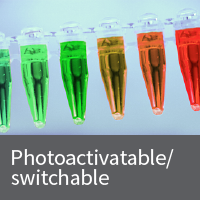Timer fluorescent protein

Study promoter activity using the Living Colors fluorescent Timer, a fluorescent protein that shifts color from green to red over time—in a matter of hours, depending on the expression system (Terskikh et al. 2000). Shortly after its synthesis, the fluorescent Timer begins emitting green fluorescence, but as time passes, the fluorophore undergoes additional changes that shift its fluorescence to longer wavelengths. When fully matured, the protein is bright red.
Study promoter activity using the Living Colors fluorescent Timer, a fluorescent protein that shifts color from green to red over time—in a matter of hours, depending on the expression system (Terskikh et al. 2000). Shortly after its synthesis, the fluorescent Timer begins emitting green fluorescence, but as time passes, the fluorophore undergoes additional changes that shift its fluorescence to longer wavelengths. When fully matured, the protein is bright red. Detect the Living Colors fluorescent Timer with the DsRed polyclonal antibody.
More Information
Applications
- Promoter studies
- Visualize the location and time frame of promoter activity (e.g., during embryogenesis and cell differentiation)
References
Terskikh, A. et al. "Fluorescent timer": protein that changes color with time. Science 290(5496):1585–1588 (2000).
Additional product information
Please see the product's Certificate of Analysis for information about storage conditions, product components, and technical specifications. Please see the Kit Components List to determine kit components. Certificates of Analysis and Kit Components Lists are located under the Documents tab.
Fluorescent protein related links
Takara Bio USA, Inc.
United States/Canada: +1.800.662.2566 • Asia Pacific: +1.650.919.7300 • Europe: +33.(0)1.3904.6880 • Japan: +81.(0)77.565.6999
FOR RESEARCH USE ONLY. NOT FOR USE IN DIAGNOSTIC PROCEDURES. © 2025 Takara Bio Inc. All Rights Reserved. All trademarks are the property of Takara Bio Inc. or its affiliate(s) in the U.S. and/or other countries or their respective owners. Certain trademarks may not be registered in all jurisdictions. Additional product, intellectual property, and restricted use information is available at takarabio.com.



